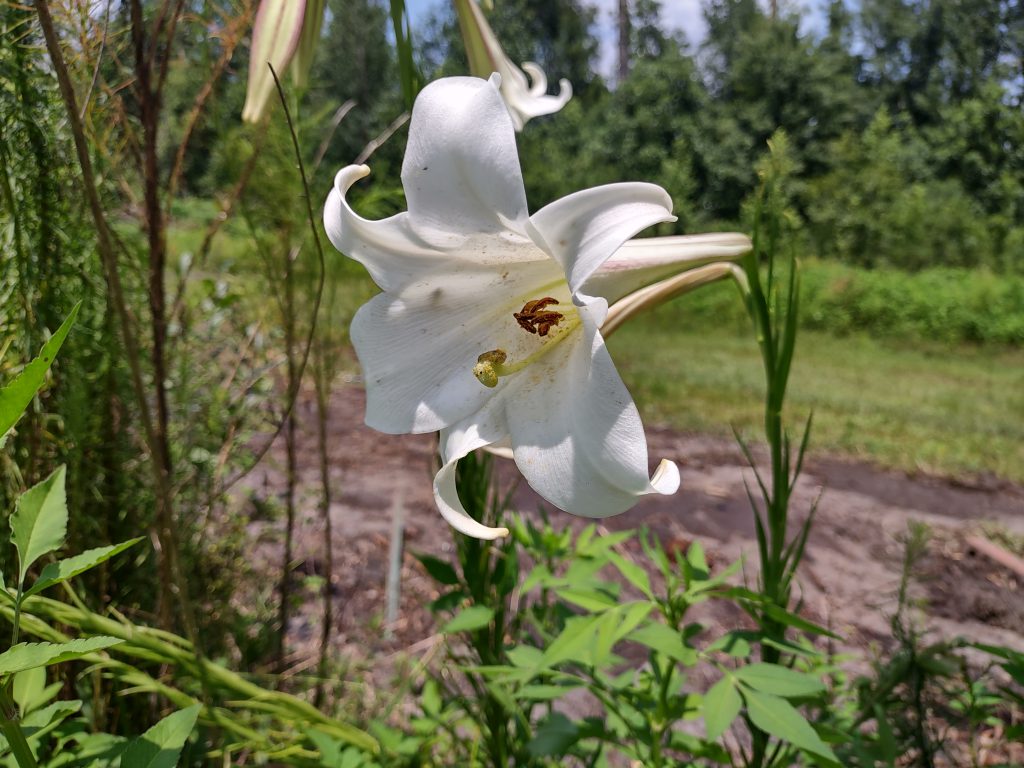Since Ponce de Leon first set foot in Florida around Easter in 1513 and gave the state its name – he called it La Florida, which loosely translates to flowery in English – Florida has been known for its amazing native wildflower displays. Florida’s primary native flower shows do indeed occur in the spring (the one observed by Ponce de Leon) and fall, but my favorite Florida “wild” flower is neither a native nor does it bloom in April or October. Rather, the Philippine Lily (Lilium formosanum) does its thing each year in the heat of the summer, when not much else wildflower-wise is blooming.
Hailing from Taiwan and the Philippines but naturalized throughout the Panhandle, the Philippine Lily is easy to spot. Often confused with Easter Lily (Lilium longiflorum), which blooms much earlier in the year, Philippine Lily blooms mid-July to August and sports classic lily-type flowers held high on study stems that may reach 7’ or higher. Emerging from the drab green of the surrounding summer landscape, Philippine Lily’s very large (10” or more), very fragrant, trumpet-shaped, creamy-white flowers are showstoppers. The propensity of the flowers to appear in elegant, “nodding” clusters of a dozen or more also adds to the effect. Admired by gardeners and other passersby during the day, at night these wonderfully scented flowers become a whirring site for evening pollinators, particularly the enormous Hummingbird, or Sphinx Moth.

In addition to being a beautiful surprise in natural areas, Philippine Lily is among the easiest and most versatile of landscape plants to grow. The species prefers partial shade, but the thousands growing along roadsides in full sun speak to its adaptability. It is also right at home in our often dry, sandy Panhandle soils, and no special soil amendments are needed for the species to thrive. To get plants started, one may use either seeds or transplants from existing stands. If using seeds, simply sow them in your desired garden location into loosened garden soil, cover lightly, and water – the same seed sowing method can be used in pots for transplanting or sharing with friends later. Alternatively, you can dig or pull bulbs from natural areas where Philippine Lily already exists – assuming you have permission from the property owner. These newly dug and planted Lilies will need babying with regular water for several weeks to reduce transplant shock and improve survival.
Philippine Lily is probably best sited in the back of landscape beds to take advantage of the plant’s height and display its flowers over lower growing perennials. Siting in the back also allows pre and post bloom Philippine Lily stalks to hide amongst other plants as they don’t add much aesthetically when not in flower. Philippine Lily pairs very well with other low-maintenance summer-blooming perennials like Black-Eyed Susan (Rudbeckia hirta), Garden Phlox (Phlox paniculata), Milkweed (Asclepias spp.), and others.
While not a native wildflower, Philippine Lily certainly adds to North Florida’s reputation as La Florida! They are among the easiest to grow, highest impact “wild” flowers Panhandle gardeners have at their disposal. Enjoy them this summer in natural areas and consider adding a few to your landscape! For more information on Philippine Lily or any other horticultural topic, contact us at the UF/IFAS Calhoun County Extension Office. Happy gardening.
- Mulch is a Must in Your Landscape - December 4, 2025
- Tis the Season – Why Winter is the Best Time to Plant Trees and Shrubs - November 26, 2025
- Feeling Blue (Ginger) This Fall - November 13, 2025
